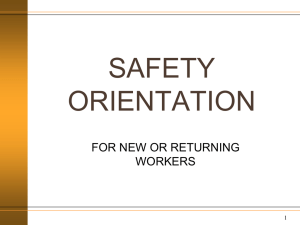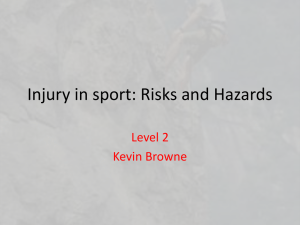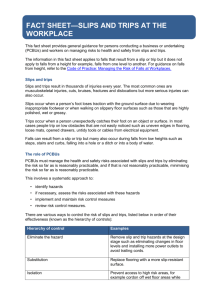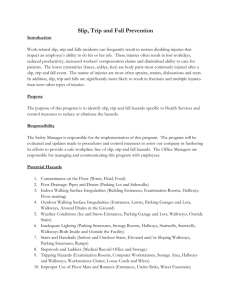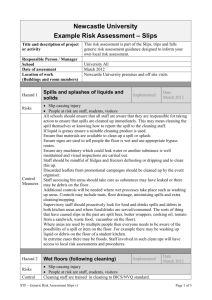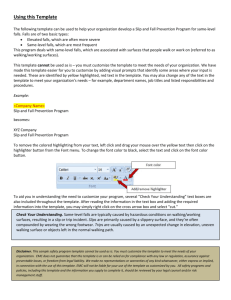SLIPS, TRIPS & FALLS
advertisement
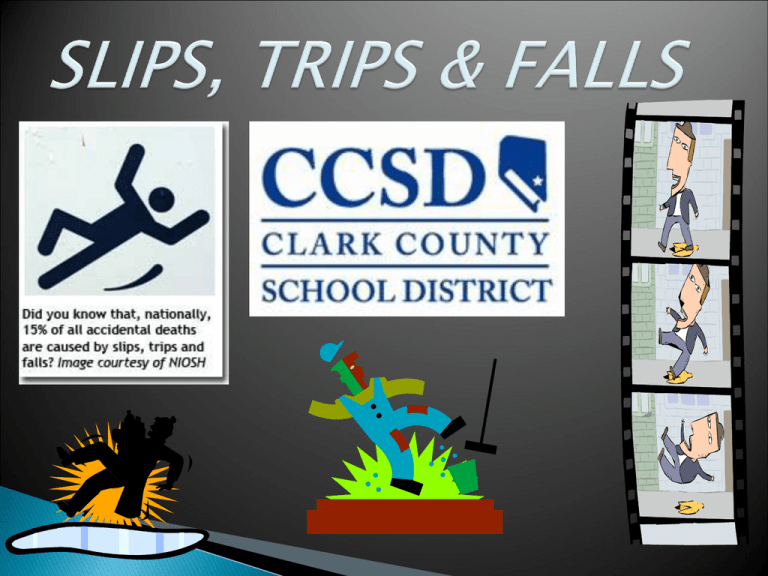
2010 #3 IN NUMBER OF INJURY CLAIMS = 9 FALL, SLIP, OR TRIP FROM: DIFFERENT ELEVATION, GREASE, LADDER, SCAFFOLDING, & TRIPPING OVER OBJECTS $14,650.00 IN INCURRED LOSS 2011 #2 IN NUMBER OF INJURY CLAIMS THUS FAR THIS YEAR=14 FALL, SLIP, OR TRIP FROM: DIFFERENT ELEVATION, ICE/SNOW, GREASE; LADDER, SCAFFOLDING, & TRIPPING OVER OBJECTS $62,723.52 IN INCURRED LOSS Most falls on a level surface does not result in a recordable injury but merely a bump, some bruises, or perhaps scattered papers and spilled coffee. But sometimes these falls can and do cause more serious injuries. A fall on a level surface can result in broken elbows and knees, fractured ankles and ribs, and even head injuries. In fact, falls on a level surface account for 20 % of lost-work-time incidents in the United States. 15% of all accidental deaths (≈12,000/year), is the second leading cause of injury behind motor vehicles. Falls are one of the most frequent type of reported injuries – about 25% of reported claims per fiscal year. Over 17% of all disabling work injuries are the result of falls. 1. Worker factors. Workers may create hazards by using equipment improperly—for example, by dragging cords across walkways or setting up ladders in unsafe locations. They also might suffer from fatigue, making them more prone to falls. And workers can engage in risk-taking behaviors that put them at increased risk, such as running in the workplace or carrying large items up or down stairs. 2. Machinery/equipment factors. Machinery that is improperly designed or maintained may create slip, trip, and fall hazards. For example, a poorly designed piece of equipment could have projections near the floor that create a tripping hazard; a poorly maintained machine may leak hydraulic fluid, creating a slip hazard. 3. Environmental factors. The work environment may include slip and fall hazards. These could be seasonal or weather-related (as when ice forms on sidewalks in winter), or they may result from poor maintenance of the overall environment (as when burned-out light bulbs are not replaced or damaged flooring is not repaired). Some environmental hazards are intermittent. For example, while sprinklers are operating, workers might walk through puddles, track water into the workplace, and leave floors slick. 4. Management practices. All of these factors can be affected positively or negatively by management practices. If management doesn't train workers in basic walking and working surface safety, workers may not report burned-out lights, clean spills quickly, or inspect ladders before each use. If management does not provide adequate staffing or budget for maintenance, machinery and equipment could become unsafe. Watch high-traffic areas. One of the more common hazards is changes in flooring surfaces, such as from carpet to tile. Try to ensure that walking surfaces are predictable, with good traction. Slow down. Very few workplaces require employees to run; workers should walk…walk…walk ….. Being in a hurry, rushing around; moving too fast for safe practices in the work environment is not needed. Clean up. All walking surfaces should be kept free of spills, especially spills of water, oil, slick powders, and any other substance that may make the floor slippery. Wear appropriate footwear. Safety-toed shoes protect worker's feet from above. In many workplaces, slip-resistant soles are a good idea; spiked or studded soles provide the best possible traction. Don't wear inappropriate shoes. Look for signs. If you must walk over slick or uneven surfaces, watch for appropriate signage. Temporary signage will warn workers of wet or damaged floors. File a report. Encourage workers to report any hazards they observe that they cannot immediately remove, such as broken tiles or floors that are wet because of roof leaks. Light the way. Workers are more likely to take a misstep when lighting is poor. Keep it dry. Some areas are prone to moisture. Control slippery hazards in these areas with adequate drainage systems and pumps or elevated walking surfaces. For example, use grated flooring to give workers a high-traction work surface while letting moisture fall through. HEAD -TUCK IT CLOSE TO YOUR CHEST, YOU’LL SHIFT YOUR CENTER OF GRAVITY FORWARD WHICH HELPS REGAIN YOUR BALANCE OR PROTECT YOUR HEAD. TEETH-GRIT THEM & YOU WON’T BITE YOUR TONGUE LEG- WHICH LEG IS SLIPPING? OPPOSITE LEG WILL STOMP IN AN ATTEMPT TO HELP YOU REGAIN YOUR BALANCE. OPPOSITE SIDES ELBOW SHOULD BE BENT SO YOU CAN LAND ON YOUR ARM & DISSIPATE SOME OF THE FORCE AWAY FROM YOUR HIP MUSCLES- THEY WILL NATURALLY TENSE, LET THEM, TENSE MUSCLES PROTECT LIGAMENTS & BONES. CORE- LAND FLAT ON YOUR REAR & THEN IN A SMOOTH MOTION ROLL ONTO YOUR HIP [THE ONE OPPOSITE YOUR SLIPPING LEG] TO HELP DIFFUSE THE FORCE OF THE FALL. THE ITEM YOUR CARRYING- TOSS IT ASIDE, UNLESS IT’S A BABY. YOUR MUSCLES ARE CONTRACTING AT A VERY HIGH RATE, THE WEIGHT OF ANYTHING BEING HELD CAN STRAIN THEM. ARMS-AS YOU FALL, FLING YOUR ARMS FORWARD & UP SO YOUR CENTER OF GRAVITY MOVES FORWARD TO STABILIZE YOURSELF. IF AFTER ALL OF THIS YOU FIND YOUR STILL FALLING, QUICKLY LOWER YOUR ARMS TO YOUR SIDES, (DON’T EXTEND THEM BACKWARD, BECAUSE YOU’LL LAND ON & POSSIBLY BREAK YOUR WRISTS.) YOUR ARMS WILL HIT THE GROUND BEFORE YOUR HIPS DO, SAVING YOU FROM A MORE DAMAGING INJURY. IF YOU FALL FORWARD, FALL INTO A PUSHUP POSITION, YOU’LL AVOID A NASTY HEAD OR BACK INJURY & YOUR BENT ELBOWS WILL REDUCE IMPACT ON YOUR WRISTS. IF THE GROUND IS SLIPPERY, TAKE SLOW SHORT STEPS & EXTEND YOUR ARMS TO THE SIDES AS IF YOUR ON A TIGHTROPE. THIS WILL HELP YOUR BALANCE & POSITION YOUR ARMS TO BE WHERE THEY NEED TO BE IN CASE THINGS GO SOUTH ON YOU. A portion of the sidewalk has given way to a sink-hole. If you look in the upper left hand corner you will see a barricade. Anytime a significant size hole is identified on walking surface, barricades or indicators of some sort should be installed around the hole to prevent a trip and fall. Slip: if it is wet outside Trip: the mat is folded Fall: both a wet floor and the mat is folded back, then the floor is getting wet instead of the mat absorbing the water. back and someone could catch their foot on the mat and trip. and caught foot could contribute to a fall. • pain • lost wages • temporary or permanent disability • reduced quality of life • depression • loss in productivity and business • increased industrial insurance premiums • costs associated with training replacement worker If you cannot fix the hazard yourself then: Immediately report the hazard Alert or warn others in the area ***Mark the area or stay there until help arrives Hazards not fixed in a timely manner Contact Risk Management 1. 2. _______ ________ are good indicators that a hazard has been identified. So far in 2011 CCSD has incurred costs of approximately $_______ for slip, trip, and fall injuries. a. 6,200.00 b. 620.00 c. 62,000.00 d. 6.20 3. 4. An employee injury does not produce a loss in productivity because other employees are able to fill in. True or False _________ is a good safeguard to prevent fall injuries. Caution Signs are good indicators that a hazard has been identified. So far in 2011 CCSD has incurred costs of approximately $ _______ for slip, trip, and fall injuries 1. 2. a. 3. 4. 6,200.00 b. 620.00 c. 62,000.00 d. 6.20 An employee injury does not produce a loss in productivity because other employees are able to fill in. True or False _________ is a good safeguard to prevent fall injuries. (correct shoes, clear aisles, cleaning up spills, proper lighting, any of these, plus more)


